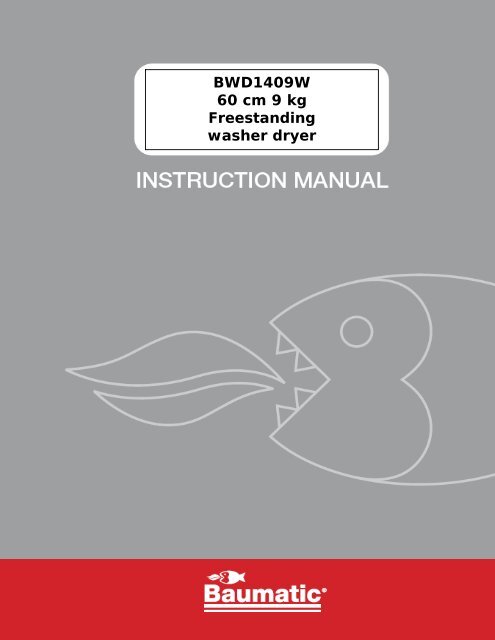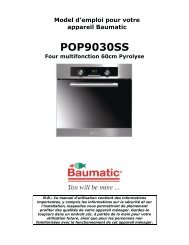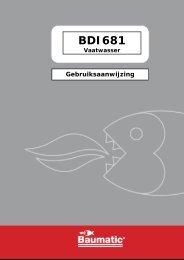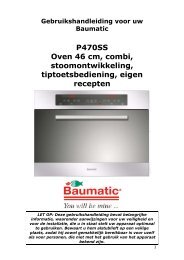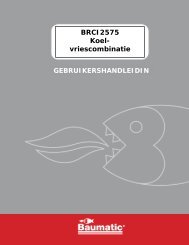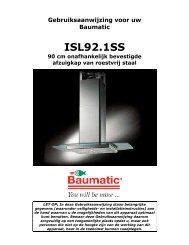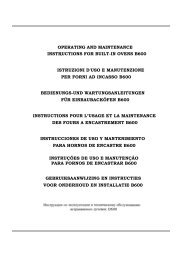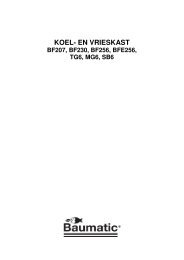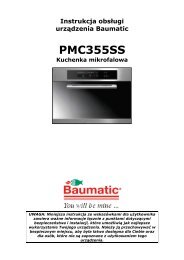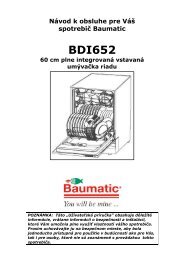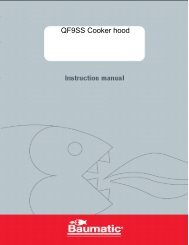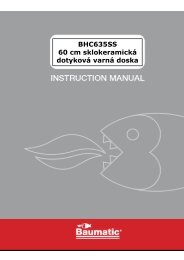BWD1409W 60 cm 9 kg Freestanding washer dryer - baumatic.cz
BWD1409W 60 cm 9 kg Freestanding washer dryer - baumatic.cz
BWD1409W 60 cm 9 kg Freestanding washer dryer - baumatic.cz
You also want an ePaper? Increase the reach of your titles
YUMPU automatically turns print PDFs into web optimized ePapers that Google loves.
<strong>BWD1409W</strong><br />
<strong>60</strong> <strong>cm</strong> 9 <strong>kg</strong><br />
<strong>Freestanding</strong><br />
<strong>washer</strong> <strong>dryer</strong>
USER MANUAL FOR YOUR BAUMATIC<br />
<strong>BWD1409W</strong><br />
<strong>60</strong> <strong>cm</strong> 9 <strong>kg</strong><br />
<strong>Freestanding</strong> <strong>washer</strong> <strong>dryer</strong><br />
NOTE: This User Instruction Manual contains important<br />
information, including safety & installation points, which will<br />
enable you to get the most out of your appliance. Please keep it<br />
in a safe place so that it is easily available for future reference; for<br />
you or any person not familiar with the operation of the appliance.<br />
GS 08/03/11<br />
2
Contents<br />
Environmental note 4<br />
Important safety information 5 – 6<br />
Specifications 7 – 12<br />
Description of the appliance 8<br />
Control panel 9 - 10<br />
LED display 11<br />
Detergent drawer 12<br />
Preparing the wash cycle 13 - 16<br />
Preparing your garments for washing 13<br />
A selection of wash care symbols 14<br />
Detergents and conditioners 14 - 15<br />
Wash program table 15 - 16<br />
Wash program guidance 16<br />
Selecting a wash program 17 - 25<br />
Descriptions of the wash programs 17 – 23<br />
End of cycle 23<br />
Pausing a wash program 23<br />
Changing a wash program 23 - 24<br />
Delay start feature 24<br />
Child lock 25<br />
Maintenance and cleaning 25 - 31<br />
In daily use 25<br />
Control panel and <strong>washer</strong> <strong>dryer</strong> cabinet 25<br />
Detergent drawer 25 - 26<br />
The <strong>washer</strong> <strong>dryer</strong> drum 26<br />
Door 26<br />
95° maintenance wash 26 - 27<br />
Cleaning the drain pump filter 27 – 28<br />
Cleaning the water inlet filter 28<br />
Winter storage 28<br />
Removing stains 28<br />
Stain removal rules 29<br />
Stain removal guide 29 - 30<br />
Poor wash results 31<br />
Installation 32 - 37<br />
Removing the transit bolts 32<br />
Locating your <strong>washer</strong> <strong>dryer</strong> 33<br />
Connecting to the mains water supply 33 - 34<br />
Connecting to the water outlet 35<br />
Levelling the appliance 35 - 36<br />
Power supply 36 - 27<br />
Before first use maintenance wash 37<br />
Error code failure system 37 – 39<br />
General troubleshooting 39 – 40<br />
Contact details 41<br />
3
Environmental note<br />
o The packaging materials that Baumatic uses are environmentally<br />
friendly and can be recycled.<br />
o Please discard all packaging material with due regard for the<br />
environment.<br />
4
Important safety information<br />
General Safety<br />
Your safety is of the utmost importance to<br />
Baumatic. Please make sure that you read this<br />
instruction booklet before attempting to install or<br />
use the appliance. If you are unsure of any of the<br />
information contained in this booklet, please<br />
contact the Baumatic Advice Line.<br />
o Repairs to your appliance must only be carried out by a<br />
Baumatic engineer or one of its authorised service agents. Any<br />
attempt by an inexperienced person to repair the appliance,<br />
could result in injury or damage to your <strong>washer</strong> <strong>dryer</strong>.<br />
o If you notice that the mains cable is damaged. The appliance<br />
must not be used. The same applies if you notice that the<br />
worktop, control panel or base area is damaged. As this could<br />
allow access to the internal components of the machine.<br />
o The appliance should be turned off and isolated from the mains<br />
supply, before either cleaning or maintenance work is attempted.<br />
o The mains cable must not be used to pull the plug out of the<br />
electrical socket.<br />
o The machine should not be sprayed with water.<br />
o The glass of the porthole door may become hot during the higher<br />
temperature wash programs.<br />
o The machine should be allowed to cool before carrying out an<br />
emergency drain or cleaning the drain filter.<br />
o It is possible for small animals to chew either the mains cable or<br />
water hoses, which could cause an electric shock hazard.<br />
Installation<br />
o The installation instructions contained within this user manual<br />
should be followed.<br />
o It is obligatory for the completed installation to comply with all<br />
relevant building regulations and local water authority<br />
requirements.<br />
5
o Before the first use of the appliance, we advise that a 95<br />
degree cotton wash is completed. No garments should be<br />
placed inside the machine; however a small amount of<br />
detergent must be used.<br />
During Use<br />
o It is recommended that the appliance is unplugged and the<br />
water supply is turned off after the machine is used.<br />
o This appliance is only designed to wash normal domestic<br />
washloads. If you use your <strong>washer</strong> <strong>dryer</strong> in any other way or it is<br />
incorrectly used, then Baumatic accepts no liability for any<br />
damage that might be caused and any guarantee will be void.<br />
o No attempt should be made to alter or modify the specifications<br />
of this appliance.<br />
o The detergents that you place in this appliance should be<br />
suitable for automatic <strong>washer</strong> <strong>dryer</strong>s. With regards to dosage<br />
levels, the detergent manufacturer’s recommendations should be<br />
followed.<br />
o You should not wash garments that have been in contact with<br />
flammable materials.<br />
o Your <strong>washer</strong> <strong>dryer</strong> should not be used for dry cleaning.<br />
o If you use either dyes or bleaching agents inside this machine,<br />
then you should consult with the manufacturer of these products<br />
to make sure they are suitable for use in your <strong>washer</strong> <strong>dryer</strong>.<br />
Baumatic cannot be held responsible for any damage that may<br />
result.<br />
Child Safety<br />
o Your <strong>washer</strong> <strong>dryer</strong> should only be used by adults. You should not<br />
allow children in the area of the machine unsupervised. You<br />
should not let them touch the controls or play with the appliance.<br />
o It could be possible for a child or pet to gain access to the<br />
<strong>washer</strong> <strong>dryer</strong> through the porthole door. Therefore please check<br />
the drum before using the appliance.<br />
o Any packaging that is removed from the machine should be kept<br />
away from children.<br />
o All detergents should be kept out of a child’s reach and in a safe<br />
place.<br />
6
Specifications<br />
o 18 wash programs<br />
o 5 drying programs<br />
o 9 <strong>kg</strong> wash load<br />
o 7 <strong>kg</strong> drying load<br />
o 1400 rpm maximum spin speed<br />
o LED display<br />
o Delay start<br />
o Digital condensing dry system<br />
o Digital countdown indicator<br />
o Wash phase indicator<br />
o Tilted drum<br />
o Air bubble washing system<br />
o 488 mm porthole and 180° door opening<br />
o Antibacterial surface<br />
o Failure detection system<br />
o Imbalance control system<br />
o Overflow protection<br />
o Foam protection<br />
o Adjustable feet<br />
o Direct drive system<br />
o Safety door lock<br />
Appliance dimensions<br />
Height: 850 mm<br />
Width : <strong>60</strong>0 mm<br />
Depth: 645 mm<br />
Energy ratings<br />
Energy efficiency class (wash only) A+<br />
Wash performance class A<br />
Water extraction performance class A<br />
For future reference please record the following information which can<br />
be found on the rating plate and the date of purchase which can be<br />
found on your sales invoice. The rating plate for your <strong>washer</strong> <strong>dryer</strong> will<br />
either be located on the right hand side of the cabinet or behind the<br />
porthole door.<br />
Model Number ……………………………….<br />
Serial Number ……………………………….<br />
Date of Purchase ……………………………….<br />
7
Description of the appliance<br />
Accessories<br />
8
Control panel<br />
again.<br />
1) Power button. Press this button to turn the power on or<br />
off.<br />
2) Start/pause button. Operation and temporary stop is<br />
repeated as it is pressed. When you want to change a<br />
program while it is in use, press this button, then select the<br />
program you want to change to, and then press this button<br />
3) Wash program selection<br />
knob. You can select the wash<br />
cycle you want by rotating the<br />
knob to choose from 8 options<br />
around the outside.<br />
4) Temperature button. This button can be used to<br />
adjust the temperature of the water according to the type<br />
of load that needs cleaning. As the button is pressed, the<br />
temperature of the water can be selected through the<br />
following options:<br />
Cold 30°C 40°C <strong>60</strong>°C 95°C<br />
9
5) Spin button. By pressing this button, the spin speed<br />
can be chosen. You can set the spin speed by rpm through<br />
the following options:<br />
Rinse Hold 400 800 1000 1400<br />
6) Wash button. You can select the cycle you want by<br />
using this button. The light of the chosen cycle will glow<br />
after selection. As the button is pressed, the wash cycle is<br />
chosen through the following options:<br />
Wash Soak Pre-wash<br />
7) Dry button. You can select the dry cycle you require by<br />
pressing this button. You can choose through the following<br />
options, depending on how dry you want your items to be:<br />
Low temp Iron Cupboard Very Time<br />
8) Water + button. You can press this button to add an extra 6 litres<br />
of water to the rinse section of any wash cycle, to increase the rinse<br />
performance without lengthening time it takes to complete.<br />
9) Delay start button. This button can be used to delay the start of<br />
the wash cycle from between 1 – 12 hours.<br />
10) Memory button. You can use this button to recall a cycle that you<br />
have previously programmed the <strong>washer</strong> <strong>dryer</strong> to remember.<br />
11) Rinse + button. You can press this button to introduce an<br />
additional rinse, which will help to remove traces of detergent residue.<br />
10
LED display<br />
Wash cycle progress indicator<br />
This lights when a wash cycle is in progress, to indicate what stage of<br />
the wash cycle the appliance has reached from:<br />
Wash Rinse Dry Spin<br />
Wash display<br />
This lights the wash functions that have been selected such as a prewash<br />
or a soak.<br />
Wash program temperatures<br />
This light indicates which wash temperature has been selected.<br />
Spin speeds<br />
This light indicates whether a spin speed has been selected.<br />
Child lock<br />
This light indicates that the child lock has been switched on.<br />
Door lock<br />
This light indicates that the automatic door lock has been activated as<br />
the cycle is in progress.<br />
Timer display<br />
This indicates how long is left of the wash cycle that is in progress.<br />
Dry display<br />
This indicates which drying cycle has been selected.<br />
11
Detergent drawer<br />
Main wash section<br />
This compartment should have detergent placed in it (you should also<br />
put a water softening agent in this section, if you use one). The<br />
detergent will be added to the drum at the start of the main wash<br />
program.<br />
Conditioner section<br />
This compartment should be used for liquid conditioners (fabric<br />
softener, starch). They will be added to the wash load during the final<br />
rinse.<br />
Pre wash section<br />
This compartment should have detergent placed in it, if you are going<br />
to select a pre-wash before the main wash cycle.<br />
12
Preparing the wash cycle<br />
Preparing your garments for washing<br />
o Your washing should be sorted out, according to<br />
the fabric type and the wash care symbol that is<br />
printed on the garment’s wash care label (see<br />
separate section on wash care symbols).<br />
o Your washing should also be sorted out<br />
according to the degree of soiling.<br />
o Check all pockets on a garment to make sure<br />
that they are empty.<br />
o Remove any detachable metal items (badges,<br />
paperclips, safety pins etc).<br />
o Zips should be closed, duvet covers and pillow cases should be<br />
buttoned up and any loose straps should be tied up. This will<br />
help to prevent other garments from getting damaged during the<br />
wash.<br />
o Woollens and knitted coloured fabrics should be turned inside out<br />
before being washed in the appliance.<br />
o Small delicate items (tights, baby socks) should be placed in<br />
either a washing net or a zipped pillow case.<br />
o Curtains should be handled with particular care. All plastic hooks<br />
or metal strips must be removed before being washed in the<br />
appliance.<br />
o Coloured items and whites should be washed<br />
in separate wash cycles.<br />
o New garments often contain an excess of<br />
dye, therefore it is advisable to wash them separately for their<br />
first wash.<br />
o Garments should be unfolded and shook out before being placed<br />
inside the machine.<br />
13
A selection of wash care symbols<br />
Washing<br />
Dry<br />
cleaning<br />
Spin<br />
<strong>dryer</strong><br />
Ironing<br />
Boiling<br />
temp<br />
95°C<br />
Delicate<br />
temp<br />
30°C<br />
Normal<br />
110°C<br />
Normal<br />
temp<br />
<strong>60</strong>°C<br />
Delicate<br />
temp<br />
40°C<br />
Low<br />
150°C<br />
Normal<br />
temp<br />
40°C<br />
Hand<br />
wash<br />
only<br />
High<br />
200°C<br />
Do not<br />
wash!<br />
All<br />
solvents<br />
Do not<br />
dry!<br />
Do not<br />
iron!<br />
Bleachable<br />
in cold<br />
water<br />
All but TRI<br />
Hang to<br />
dry<br />
Do not<br />
bleach!<br />
Benzine<br />
only<br />
Drip dry<br />
Wool<br />
seal<br />
Do not<br />
clean!<br />
o The wash care symbols should be used to help you to select the<br />
most suitable wash program. They will also help you to sort your<br />
laundry into different loads, depending on the fabric type and the<br />
highest temperature which the garment can be washed at.<br />
Detergents and conditioners<br />
The amount of detergent that you need to use in your appliance, will<br />
depend on<br />
o The degree of soiling. Lightly soiled garments in general<br />
require less detergent.<br />
o The size of the wash load. A smaller wash load will require a<br />
reduction in the amount of detergent.<br />
o The hardness of your tap water. The harder your water is,<br />
then the more detergent you will need to use. The detergent<br />
manufacturers normally give guidance as to how much extra<br />
detergent should be used, depending on the hardness of the<br />
water.<br />
Liquid detergent<br />
If you are using liquid detergent, then in the majority of cases the<br />
liquid should be placed inside the dosing device supplied by the<br />
Dry<br />
flat<br />
14
detergent manufacturer and placed inside the drum. All instructions on<br />
the detergent packaging should be followed.<br />
Water softening agents<br />
If your tap water is hard, then it may be prudent to utilise a water<br />
softening agent. This will help to ensure that the appliance does not<br />
become clogged with hard water deposits. You may also find that it will<br />
allow you to lessen the amount of detergent that you are using.<br />
When using any detergent or water softening<br />
agent, the recommendations of the<br />
manufacturers should be followed.<br />
Wash program table<br />
Program Fabric type Proper Option Maximum<br />
temp.<br />
Load<br />
Cotton/ First check if laundry is <strong>60</strong>°C Pre-wash 9<strong>kg</strong><br />
Normal machine washable (white (Cold, 30°C, + rinse<br />
cotton, linen towel and 40°C,<br />
sheets).<br />
Colourfast garments (shirts,<br />
night dresses, pyjamas, and<br />
lightly soiled white cottons,<br />
underwear).<br />
95°C).<br />
Synthetic Polyamide, acrylic, polyester 30°C (Cold, Pre-wash Less than<br />
40°C). + rinse 3<strong>kg</strong>.<br />
Delicate/ Delicate laundry easily Cold* Less than<br />
handwash damaged (silk, curtains).<br />
3<strong>kg</strong>.<br />
Intensive Heavy soiled clothes (blue- <strong>60</strong>°C (Cold, Pre-wash Less than<br />
jeans, climbing clothes, ruck 30°C, 40°C, + rinse 3<strong>kg</strong><br />
sack, sports wear).<br />
95°C).<br />
Quick 20 Coloured laundry which is Cold* Less than<br />
lightly soiled.<br />
3<strong>kg</strong>.<br />
Sports wear Lightly soiled fast and thin Cold (Cold, Pre-wash<br />
laundry.<br />
30°C,<br />
40°C).<br />
+ rinse<br />
Tub clean Use to clean (and dry). Cold Dry Without<br />
load.<br />
Drain Drain water in drum to<br />
outside.<br />
Pre Wash: If the laundry is heavily soiled, the pre-wash option is<br />
recommended. This option is available for cotton and synthetic wash<br />
programs. You should place detergent in the pre-wash compartment of<br />
the detergent drawer, as well as in the main wash compartment.<br />
Rinse+: Will introduce an additional rinse, which will help to remove<br />
traces of detergent residue.<br />
15
Water+: This will add an extra 6 litres of water to the rinse section of<br />
any cycle to increase the rinse performance without lengthening the<br />
cycle time.<br />
Wash program guidance<br />
o A wash program option can only be selected if the program table<br />
advises that it is possible with the wash cycle you have selected.<br />
o The <strong>washer</strong> <strong>dryer</strong> automatically selects a temperature for a<br />
particular wash program. However it is possible to alter the<br />
temperature by using the temp button. All temperatures will not be<br />
available on certain wash programs.<br />
o The <strong>washer</strong> <strong>dryer</strong> automatically selects a spin speed for a particular<br />
wash program. However it is possible to alter the spin speed by<br />
using the spin button. All spin speeds will not be available on<br />
certain wash cycles.<br />
o Important: You should make sure that the selected spin speed is<br />
appropriate for the garments that you are washing.<br />
o Important: Before opening the door of the appliance, you MUST<br />
spin the clothes and drain the water. See the section called “Spin<br />
only”.<br />
o The active phases will appear at the top of the LED display, as the<br />
wash program progresses.<br />
o The LCD display shows an approximate time for the selected wash<br />
cycle. Please note that factors external to the machine, e.g. the<br />
temperature of your water supply, your water pressure etc. can<br />
affect the time it takes for a wash cycle to complete.<br />
16
Selecting a wash program<br />
Cotton program<br />
o Put the laundry into the drum and then close the door. The<br />
maximum load size is 9<strong>kg</strong> for a cotton wash.<br />
o In the detergent drawer, put detergent into the main wash and<br />
pre-wash compartments.<br />
o Put detergent into the pre wash compartment only if you want to<br />
use the pre-wash option.<br />
o Softener should be poured into the middle compartment of the<br />
detergent drawer; the level should be below the ‘MAX’ level.<br />
o If you want to use bleach, then you should put it into the main<br />
wash compartment with your detergent.<br />
o Press and hold the power button (1), the LCD display will show<br />
“---“ and all the program lights will come on.<br />
o If you press the start/pause button (2) next without selecting a<br />
program, the cotton/normal wash will be selected as the default<br />
program.<br />
o Alternatively you can use the wash program selection knob (3)<br />
to select the cotton program.<br />
o A wash temperature of 40°C, with an 800 rpm spin will be<br />
selected automatically by the appliance.<br />
o You can use the temp button (4) to adjust the wash<br />
temperature, ‘cold’, 30°C, 40°C, <strong>60</strong>°C and 95°C wash<br />
temperatures are available.<br />
o You can use the spin button (5) to adjust the spin speed.<br />
o You can use the wash button (6) to select a pre-wash or soak to<br />
a cycle. You can also press the rinse button (11) to include a<br />
rinse.<br />
o Press the start/pause button (2), the door will lock and after a<br />
few seconds you will hear the machine start to fill with water.<br />
The machine will automatically use the appropriate amount of<br />
water by sensing the weight of your laundry.<br />
17
Synthetic program<br />
o Put the laundry into the drum and then close the door. The<br />
maximum wash load size is below 3<strong>kg</strong> for the synthetic program.<br />
o In the detergent drawer, put detergent into the main wash and<br />
pre-wash compartments.<br />
o Put detergent into the pre wash compartment only if you want to<br />
use the pre-wash option.<br />
o Softener should be poured into the middle compartment of the<br />
detergent drawer; the level should be below the ‘MAX’ level.<br />
o If you want to use bleach, then you should put it into the main<br />
wash compartment with your detergent.<br />
o Press the power button (1), the LCD display will show “---“ and<br />
all the program lights will come on.<br />
o Use the wash program selection knob (3) to select the synthetic<br />
program.<br />
o A wash temperature of 30°C, with an 800 rpm spin will be<br />
selected automatically by the appliance.<br />
o You can use the temp button (4) to adjust the wash<br />
temperature; ‘cold’, 30°C and 40°C wash temperatures are<br />
available.<br />
o You can use the spin button (5) to adjust the spin speed. A 1400<br />
rpm spin speed is not available with the synthetic wash program.<br />
o You can use the wash button (6) to select a pre-wash or soak<br />
and the rinse button (11) can be pressed to program a rinse.<br />
o Press the start/pause button (2), the door will lock and after a<br />
few seconds you will hear the machine start to fill with water.<br />
18
Delicate/ handwash program<br />
o Put the laundry into the drum and then close the door. The<br />
maximum wash load size is below 3<strong>kg</strong> for the delicate program.<br />
o In the detergent drawer, put detergent into the main wash<br />
compartment.<br />
o Softener should be poured into the middle compartment of the<br />
detergent drawer; the level should be below the ‘MAX’ level.<br />
o If you want to use bleach, then you should put it into the main<br />
wash compartment with your detergent.<br />
o Press the power button (1), the LCD display will show “---“ and<br />
all the program lights will come on.<br />
o Use the wash program selection knob (3) to select the delicate<br />
program.<br />
o A wash temperature of ‘cold’, with a 400 rpm spin will be<br />
selected automatically by the appliance. The wash temperature<br />
of ‘cold’ is not adjustable for the delicate wash program.<br />
o You can use the spin button (5) to adjust the spin speed. 1400<br />
and 1000 rpm spin speeds are not available with the delicate<br />
wash program.<br />
o You can use the rinse button (11) to select the rinse cycle<br />
option.<br />
o Press the start/pause button (2), the door will lock and after a<br />
few seconds you will hear the machine start to fill with water.<br />
19
Intensive program<br />
o Put the laundry into the drum and then close the door.<br />
o Put detergent into the main wash and pre-wash compartments in<br />
the detergent drawer. Softener should be below the ‘MAX’ level.<br />
o Put detergent into the pre-wash compartment only if you want to<br />
add pre-wash.<br />
o When you want to use bleach, put it into the main wash<br />
compartment with detergent.<br />
o Press the power button (1). The LED shows only “---“ and all<br />
program lights will turn on.<br />
o Use the wash program selection knob to select the intensive<br />
program.<br />
o Select the intensive program using the program selection dial<br />
(3). The machine will set a washing temperature of <strong>60</strong>°C and a<br />
spin speed of 1000rpm. If you want to change the washing<br />
temperature (4), the spin speed (5) or add wash options (prewash<br />
or soak) (6) or a rinse (11), then press each button<br />
accordingly.<br />
o Press the start-pause button (2). The door will lock and the<br />
machine will supply wash water depending on the weight of the<br />
laundry. The appliance will then begin washing.<br />
Quick 20 program<br />
o Put the laundry into the drum and then close the door. The<br />
maximum wash load size is below 3 <strong>kg</strong> for the Quick 20 wash<br />
program.<br />
o In the detergent drawer, put detergent into the main wash<br />
compartment.<br />
o Softener should be poured into the middle compartment of the<br />
detergent drawer; the level should be below the ‘MAX’ level.<br />
o If you want to use bleach, then you should put it into the main<br />
wash compartment with your detergent.<br />
o Press the power button (1), the LCD display will show “---“ and<br />
all the program lights will come on.<br />
20
o Use the wash program selection knob (3) to select the Quick 20<br />
program.<br />
o A wash temperature of ‘cold’, with an 800 rpm spin will be<br />
selected automatically by the appliance.<br />
o Press the start/pause button (2), the door will lock and after a<br />
few seconds you will hear the machine start to fill with water.<br />
Sports wear program<br />
o Put the laundry into the drum. Put detergent and softener into<br />
the detergent drawer. Softener should be below ‘MAX’ level.<br />
Then close the door.<br />
o Put detergent into the pre-wash compartment only if you want to<br />
add pre-wash.<br />
o When you want to use bleach, put it into the main wash<br />
compartment with detergent.<br />
o Press the power button (1) and the LED will show only “---“ and<br />
all program lights will turn on.<br />
o Select the sports wear program using the program selection dial<br />
(3). The washing temperature will be automatically set at ‘cold’<br />
with a spin speed of 800 rpm.<br />
o You can alter the temperature of the water by pressing the<br />
temperature button (4). Only ‘cold’, ‘30°C’ and ‘40°C’ are<br />
selectable.<br />
o Press the start/pause button (2) and the door will lock. The<br />
wash water supplied will be influenced by the weight of the<br />
laundry. The appliance will then begin washing.<br />
Spin only<br />
o Put the laundry into the drum and then close the door.<br />
o Press the power button (1), the LCD display will show “---“ and<br />
all the program lights will come on.<br />
o Select the spin speed (5) that you require by pressing the spin<br />
button.<br />
o The water temperature is set to ‘cold’ automatically.<br />
21
o Press the start/pause button (2), the door will lock and after a<br />
few seconds you will hear the machine start to spin.<br />
Only wash<br />
o Put the laundry into the drum and put detergent and softener<br />
into the detergent drawer. Then close the door.<br />
o Press the power button (1) and the LED will show only “---“.<br />
o Select the wash course you want by pressing the wash button<br />
(6). The temperature will automatically be set to ‘cold’.<br />
o Press the start-pause button (2) and the <strong>washer</strong> will be<br />
operated with a locked door and supplied water.<br />
Drain<br />
o Press the power button (1), the LCD display will show “---“ and<br />
all the program lights will come on.<br />
o Use the wash program selection knob (3) to select the drain<br />
program.<br />
o Press the start/pause button (2), the door will lock and after a<br />
few seconds you will hear the machine start to drain.<br />
o IMPORTANT: Please note that the appliance will not spin on this<br />
particular wash cycle.<br />
Tub clean program<br />
Dry<br />
o Press the power button (1) and the LED will show only “---“.<br />
o Select the tub clean program using the program selection dial<br />
(3). The machine will automatically set a soak program and a<br />
spin speed of 400 rpm and a ‘cold’ water temperature.<br />
o Put the laundry into the drum and close the door. The maximum<br />
load size for a drying cycle is 7 <strong>kg</strong>.<br />
o Press the power button and the LED will show “---“.<br />
o Select the level of dryness you want by pressing the dry button.<br />
Continue pressing the dry button if you want to set a length of<br />
time for a drying cycle. Once the display has scrolled through the<br />
cycles you can select a time, ranging from 1 to 4 hours.<br />
22
o Press the start/pause button (2) and the machine will begin the<br />
cycle after a few seconds.<br />
o For approximate drying times for each cycle, see the table<br />
below:<br />
Drying Cycle Approximate Time<br />
(hr.min)<br />
Time set 01.00 – 04.00<br />
Low temperature 01.40<br />
Iron 01.30<br />
Cupboard 03.30<br />
Very 04.30<br />
o It is possible to select a separate drying cycle or for the drying<br />
cycle to run on automatically from the wash cycle. IMPORTANT:<br />
If you are running on automatically from the wash cycle, please<br />
note that the maximum size of drying load is 7 <strong>kg</strong>.<br />
End of cycle<br />
o At the end of a wash cycle, the door lock light will remain lit for a<br />
couple of minutes.<br />
o IMPORTANT: You should not attempt to open the porthole door<br />
until the door lock light has gone out.<br />
o When the door lock light has gone out and you hear the door<br />
lock disengage, you can open the porthole door and remove the<br />
laundry.<br />
Pausing a wash program<br />
o If you want to pause a wash program temporarily, you should<br />
press the start/pause button (2).<br />
o When you want to restart the wash cycle, press the start/pause<br />
(2) button again.<br />
Changing a wash program<br />
o If you want to change a wash program once the wash cycle is<br />
already in progress, you should first press the start/pause button<br />
(2).<br />
o Use the wash program selection knob (3) to change the wash<br />
program to the one that you require.<br />
23
o IMPORTANT: Changing the wash program will cancel any spin<br />
or temperature alterations that you have made and any program<br />
options that you have selected. You will need to make the spin/<br />
temperature alterations again and re-select any program options<br />
that you require.<br />
Delay start feature<br />
Your appliance has a delay start feature, which allows you to delay the<br />
start of a wash cycle until a later time.<br />
o Put the laundry into the drum and close the door.<br />
o Put the detergent into the main wash compartment and prewash<br />
compartment in the detergent drawer. Softener should be below<br />
the ‘MAX’ level. Only put detergent into the prewash<br />
compartment if you want to add a prewash to your cycle.<br />
o When you want to use bleach put this in the main wash<br />
compartment with the detergent.<br />
o Press the power button (1) and the LED display will show “---“.<br />
o Press the delay start button (9). If you press the start/pause<br />
button (2) next without selecting a program, the cotton wash is<br />
selected as a default wash cycle.<br />
o Alternatively you can select a wash using the wash program<br />
selection dial (3) and you can also alter the temperature (4)<br />
and spin speed (5) by pressing the relevant buttons.<br />
o Select the time delay you require by pressing the time delay<br />
button (9). You can choose between 2 to 12 hours and the<br />
displayed time will show the program’s finishing time. The<br />
finishing time may vary depending on your selected<br />
temperature.<br />
o Press the start/pause button (2). The time delay LED should<br />
light.<br />
o The delicate, quick-20, tub-clean and drain programs cannot be<br />
selected using the time delay function. You also cannot add<br />
clothes during a time delay cycle.<br />
24
Child lock<br />
Your appliance has a child lock option, if this is set, it will mean that<br />
nobody can affect the operation of the wash program once it has<br />
started.<br />
o To activate the child-lock, press and hold the wash button (6)<br />
and the temperature button (4) at the same time for<br />
approximately three seconds.<br />
o Follow the same steps to deactivate the child-lock.<br />
Maintenance and cleaning<br />
In daily use<br />
o Once a wash cycle has completed, you should pull out the<br />
detergent drawer slightly, so it can dry out.<br />
o Leave the porthole door ajar for a short while after a wash cycle<br />
has completed. This should help to prevent stagnant smells and<br />
to protect the door seal.<br />
o Close the water tap.<br />
o We suggest that you disconnect the appliance from your mains<br />
supply, when it is not in use.<br />
Control panel and <strong>washer</strong> <strong>dryer</strong> cabinet.<br />
IMPORTANT: Do not use any abrasive cleaner or household polish on<br />
either the control panel or operating parts.<br />
o Wipe over the control panel and the external surface of the<br />
machine using a brand new damp cloth with warm water.<br />
o If you ever spill any liquid detergent or conditioner from the<br />
detergent drawer onto the <strong>washer</strong> <strong>dryer</strong> cabinet, then these<br />
should be cleaned up immediately as they could be corrosive.<br />
Detergent drawer<br />
Occasionally the detergent drawer should be cleaned, to remove any<br />
detergent residue that has built up.<br />
o Pull the detergent drawer out as far as it will go,<br />
press down the catch in the middle section of the<br />
drawer and then pull the drawer out.<br />
25
The <strong>washer</strong> <strong>dryer</strong> drum<br />
o Wash the detergent drawer in warm, soapy water.<br />
For ease of cleaning, you can remove the upper part<br />
of the fabric softener compartment.<br />
o Detergent can also accumulate inside the detergent<br />
drawer recess, so you should also clean this out<br />
using a brush<br />
o Once you have finished cleaning the detergent<br />
drawer and recess, you should slide the drawer back<br />
into its original position.<br />
The drum of your <strong>washer</strong> <strong>dryer</strong> is constructed from stainless steel.<br />
However if there are objects that can rust placed inside the drum, then<br />
it is possible for the drum to become stained.<br />
IMPORTANT: Do not use a descaling agent, iron/steel wool or<br />
scouring agents to clean the drum of your appliance.<br />
Door<br />
o Remove any rust stains on the drum with an appropriate<br />
stainless steel cleaning agent.<br />
o You should regularly check to see if any deposits have formed,<br />
or there are any foreign bodies inside or underneath the rubber<br />
door gasket. This sits inside the opening of the porthole door.<br />
95° maintenance wash<br />
Approximately once a month, you should complete a 95° maintenance<br />
wash, this is a wash cycle which you run without clothing placed in the<br />
drum but still using detergent. This helps prevent the build-up of<br />
bacteria inside of the drum and the rest of the appliance.<br />
o Place detergent in the main wash section of the detergent<br />
drawer. Ideally you should use a power or liquid detergent that<br />
contains bleach.<br />
o Select a 95° cotton wash.<br />
o Press the start/pause button (2), the door will lock and after a<br />
few seconds you will hear the machine start to fill with water.<br />
26
o At the end of the wash cycle, you should leave the porthole door<br />
open for a short period of time.<br />
Cleaning the drain pump filter<br />
IMPORTANT: Switch off your <strong>washer</strong> <strong>dryer</strong> and disconnect the plug<br />
from your mains supply.<br />
You should clean out the filter approximately every ten washes.<br />
If the drain pump filter is not cleaned regularly, then your<br />
appliance may find it difficult to pump out water efficiently.<br />
o You should regularly check to see if any deposits have formed,<br />
or there are any foreign bodies in the drain pump filter.<br />
o Locate the drain pump filter flap that is on the base of the<br />
appliance in the front right hand corner.<br />
o Use a coin to open the drain pump filter flap.<br />
o Pull out the bail tube that is to the left of the<br />
drain pump filter. Place the end of the tube into<br />
an adequately sized bowl and then remove the<br />
cap from the end of it.<br />
o When water no longer runs out of the bail tube, you can turn the<br />
drain pump filter cover anti-clockwise. This will allow you to<br />
remove the drain pump filter from its housing.<br />
o Remove any debris from the drain pump filter by running it<br />
under a tap.<br />
o After cleaning, reinsert the drain pump filter into its housing.<br />
Tighten the drain pump filter by turning it clockwise, you should<br />
keep tightening it until you cannot turn it any further.<br />
o Reinsert the cap into the end of the bail hose,<br />
making sure that it is securely in place. Slide the<br />
bail hose back into its original position and then<br />
close the drain pump filter flap.<br />
27
IMPORTANT: If you are draining water from the bail hose and drain<br />
pump filter in an emergency. You should take care as the water<br />
coming from the machine mid-cycle could be hot. Especially if the<br />
water is being drained in the middle of one of the hotter wash cycles.<br />
Cleaning the water inlet filter<br />
o Clean the filter when water leaks from the water inlet.<br />
o Always pull the power plug out before cleaning.<br />
o Turn off the water supply to the <strong>washer</strong> and separate the inlet<br />
hose.<br />
o Pull the inlet filter out. Remove the dirt from the inlet filter with<br />
a brush and replace.<br />
Winter storage<br />
o You should install your appliance in a location where it will not be<br />
subjected to freezing temperatures.<br />
o If you are going to store your appliance in a location where the<br />
temperature will drop below freezing in winter, then you should<br />
follow the table below.<br />
To winterize the <strong>washer</strong> To use the <strong>washer</strong> again<br />
• Turn off the water supply.<br />
• Disconnect and drain the water<br />
inlet hoses.<br />
• Run the <strong>washer</strong> on a drain and<br />
spin setting for one minute.<br />
• Unplug the power supply cord.<br />
Removing stains<br />
• Flush the water pies<br />
and hoses.<br />
• Reconnect the water<br />
inlet hoses.<br />
• Turn on the water<br />
supply.<br />
• Reconnect the power<br />
supply cord.<br />
Garments that are covered in stains, grease or are heavily soiled may<br />
need to be pre-washed or soaked before being placed inside of the<br />
<strong>washer</strong> <strong>dryer</strong>.<br />
o Soaking helps to remove protein-type stains, like blood, milk or<br />
grass.<br />
o Pre-washing helps to loosen soil before the main wash.<br />
28
Stain removal rules<br />
o Use warm water for soaking or pre-washing stained laundry. Hot<br />
water can set stains.<br />
o Most stains are easier to remove when they are fresh.<br />
o Before treating any stain try to establish; what kind of stain it is,<br />
how old the stain is, what the fabric type is and whether the<br />
fabric is colourfast (check the care label to find this out).<br />
o Washing and drying can fix some stains.<br />
o When bleach is recommended, use a mild fabric bleach that is<br />
safe for the fabric.<br />
o If you need to use a stain remover, put the stained area face<br />
down on a paper towel or white cloth. Apply the stain remover to<br />
the back of the stain. This forces the stain off the fabric, instead<br />
of through it.<br />
Stain removal guide<br />
Stain Removal Method<br />
Alcoholic<br />
beverages<br />
The stain should be first washed with cold water, then<br />
wiped with glycerine and water and rinsed with water<br />
mixed with vinegar.<br />
Shoe polish The stain should be softly scratched without ruining the<br />
material, then rubbed with detergent and rinsed. In case<br />
it is not eliminated, rub with 1 unit of pure alcohol (96<br />
degrees) mixed in 2 units of water and then washed with<br />
lukewarm water.<br />
Tea and<br />
coffee<br />
Chocolate<br />
and cocoa<br />
Tomato<br />
paste<br />
Meat broth/<br />
egg<br />
Grease and<br />
oil stains<br />
Stretch the stained area of material on the top of a<br />
container and pour water as hot as the material can<br />
endure on it. If the type of material is suitable, wash it<br />
with lye.<br />
Leave your clothes in cold water and rub with soap or<br />
detergent, wash it in the highest temperature that the<br />
material type can endure. If there is still a stain of oil left,<br />
wipe with oxygenated water (in proportion of 3%).<br />
Scrape the dried pieces without ruining the material, then<br />
leave in cold water for about 30 minutes and wash by<br />
rubbing with detergent.<br />
Eliminate the dried stain residues and wipe with a sponge<br />
or soft cloth wetted in cold water. Rub with detergent and<br />
wash with diluted lye.<br />
First wipe the residues. Rub the stain with detergent and<br />
then wash with lukewarm soapy water.<br />
Mustard First apply glycerine to the stained area. Rub with<br />
detergent and then wash. If the stain still does not<br />
disappear, wipe with alcohol (on synthetic and coloured<br />
29
cloth, a mixture of 1 unit alcohol, 2 units water should be<br />
used).<br />
Blood stain Lay your clothes in cold water for 30 minutes. If the stain<br />
still does not disappear, lay in mixture of water and<br />
ammonia (3 table-spoons of ammonia in 4 litres of water)<br />
for 30 minutes.<br />
Cream, icecream<br />
and<br />
milk<br />
Lay your clothes in cold water and rub the stained area<br />
with detergent. If the stain has still not disappeared,<br />
apply lye on the fabric of your clothes in proper<br />
proportion. (Do not use lye on coloured clothes).<br />
Mould Mould stains should be cleaned as soon as possible. The<br />
stain should be washed with detergent, and if it does not<br />
disappear, it should be wiped with oxygenated water (in<br />
proportion of 3%).<br />
Ink Hold the stained area under cold water and wait until the<br />
inky water completely runs off. Then rub with water<br />
diluted with lemon juice and detergent. Wait five minutes<br />
and then wash.<br />
Fruit Stretch the stained area of your clothes on the top part of<br />
a container and pour cold water on it. Do not pour hot<br />
water on the stain. Wipe with cold water and apply<br />
glycerine. Wait for 1-2 hours and rinse after wiping with a<br />
few drops of white vinegar.<br />
Grass stain Rub the stained part with detergent. If the type of fabric<br />
is suitable for use of lye, wash it with lye. Rub your<br />
woollen clothes with alcohol (for coloured one, a mixture<br />
of 1 unit pure alcohol and 2 units of water).<br />
Oil paint The stain should be eliminated before it dries by applying<br />
thinner on it. Then it should be rubbed with detergent and<br />
washed.<br />
Burnt stain If your fabric is suitable for the use of lye, you can add<br />
lye into your washing water. For woollen fabrics, a cloth<br />
dampened in oxygenated water should be pressed on the<br />
stain and it should be ironed with a dry cloth on it. It<br />
should be washed after rinsing well.<br />
30
Poor wash results<br />
My garments are looking grey and there are limescale<br />
deposits present in the drum of my <strong>washer</strong> <strong>dryer</strong>.<br />
o There is not enough detergent being added.<br />
o The incorrect detergent is being used.<br />
o Stains are not being pre-treated.<br />
o The correct wash program or wash temperature was not<br />
selected.<br />
I have followed the advice given above, but my<br />
garments are still coming out with grey stains on them.<br />
o The garments are soiled with oils, ointments or grease<br />
and were washed without enough detergent.<br />
o The wash temperature selected was too low.<br />
o Fabric conditioner has come into contact with the<br />
garments. If this happens try to wash out these stains<br />
as quickly as you can and try to avoid getting<br />
conditioner on the garments in future.<br />
After the final rinse, I can still see foam.<br />
o Modern detergents can result in there still being foam in the final<br />
rinse, this does not mean that the washing is not being rinsed<br />
properly.<br />
There is white residue on my garments when I remove<br />
them from the appliance.<br />
o Modern detergents can contain insoluble contents; white residue<br />
after a wash cycle is not necessarily a sign of the garments being<br />
insufficiently rinsed by the <strong>washer</strong> <strong>dryer</strong>.<br />
o You should shake out the garment or brush it off. In future possibly<br />
turn the garment inside out before it is washed. You may wish to<br />
move from a powder detergent and switch to a liquid detergent<br />
instead.<br />
31
Installation<br />
IMPORTANT: THIS INSTALLATION MUST BE<br />
COMPLETED BY A SUITABLY QUALIFIED PERSON.<br />
BAUMATIC ONLY SANCTION THE INSTALLATION<br />
GIVEN IN THIS INSTRUCTION MANUAL. YOU<br />
SHOULD KEEP THE TRANSIT PACKAGING, IN CASE<br />
YOU NEED TO TRANSPORT THE MACHINE IN THE<br />
FUTURE.<br />
Removing the transit bolts<br />
IMPORTANT: Before installing or operating the <strong>washer</strong> <strong>dryer</strong>, YOU<br />
MUST remove the transit bolts that hold the drum in position whilst<br />
the appliance is being transported.<br />
o On the rear of the appliance,<br />
identify the 4 transit bolts.<br />
o Using the spanner<br />
supplied, unscrew the 4<br />
transit bolts.<br />
o You should keep the 4 transit bolts and spanners, in case you<br />
need to transport the appliance elsewhere in future.<br />
o Cover the holes that you removed the<br />
transit bolts from, using the 4 transit<br />
covers supplied.<br />
32
Locating your <strong>washer</strong> <strong>dryer</strong><br />
o Before commencing installation, check<br />
the location where you intend to install<br />
the appliance. You should make sure that<br />
you have everything in place that is<br />
necessary for the correct installation.<br />
o Do not place or store your <strong>washer</strong> <strong>dryer</strong> in a location where the<br />
ambient temperature could fall below 0°C, otherwise the water<br />
in it could freeze up.<br />
o Never place or store laundry products on top of the appliance.<br />
o Install the <strong>washer</strong> on a flat, solid floor. If the <strong>washer</strong> is installed<br />
on an uneven or suspended floor, it could cause excessive noise<br />
and severe vibration, which may result in the malfunction of the<br />
appliance.<br />
o You should also level off the <strong>washer</strong> <strong>dryer</strong>, using the adjustable<br />
feet on the base of the appliance.<br />
o There should be a gap of 2 <strong>cm</strong> either side of the <strong>washer</strong> <strong>dryer</strong>; a<br />
10 <strong>cm</strong> gap should be left behind the appliance.<br />
Connecting to the mains water supply<br />
IMPORTANT: The <strong>washer</strong> <strong>dryer</strong> should never be connected to the<br />
water mains using an existing inlet hose, YOU MUST utilise the inlet<br />
hose that is provided with the appliance.<br />
Your appliance should only be connected to a cold water supply.<br />
33
For an ordinary tap<br />
For a screw-shaped tap<br />
34
Connecting<br />
to the water outlet<br />
Secure the drain<br />
<strong>dryer</strong> is in use.<br />
Levelling<br />
the appliance<br />
hose, so that it cannot move whilst the <strong>washer</strong><br />
Place the end of the drain hose on<br />
your drain pipe. Push it a short<br />
way<br />
down into your drain pipe.<br />
IMPORTANT: Do not insert the<br />
drain hose too deeply into the water<br />
pipe, as this may cause siphoning.<br />
Utilise the outlet hose retainer and<br />
tie strap to keep the outlet hose in<br />
position when<br />
the appliance is on a<br />
wash cycle.<br />
NEVER EXTEND THE DRAINAGE<br />
HOSE FROM<br />
ITS ORIGINAL<br />
LENGTH.<br />
Place the <strong>washer</strong> <strong>dryer</strong> on a solid and level floor surface.<br />
DO NOT PLACE THE WASHER<br />
DRYER ON A CARPET OR A<br />
SUSPENDED FLOOR.<br />
35
IMPORTANT: There should be no instability of the machine when the<br />
adjustable legs have been set to the correct level.<br />
Power supply<br />
IMPORTANT:The<br />
electrical socket<br />
must still be<br />
accessible once<br />
the appliance is<br />
installed.<br />
Consult the rating plate, located on<br />
the inner rim of the porthole door or<br />
the right hand side of the cabinet<br />
BEFORE making the electrical<br />
connections. Ensure that the voltage<br />
reaching the plug, is the same as that<br />
on the rating plate.<br />
DO NOT REMOVE THE RATING PLATE AS THE<br />
INFORMATION ON IT IS IMPORTANT.<br />
The moulded plug that is supplied with the appliance must be<br />
placed into an earthed and insulated socket.<br />
Broken or damaged power leads must only be replaced by a<br />
suitably qualified person. A power lead of a similar type must be<br />
used in replacement.<br />
36
IMPORTANT: We do not recommend that this appliance is<br />
connected to an extension lead.<br />
Before first use maintenance wash<br />
o When your <strong>washer</strong> <strong>dryer</strong> has been correctly installed, we<br />
recommend that you perform a maintenance wash cycle, without<br />
any clothing being placed inside of the drum.<br />
o This will check that all aspects of the installation are correct; it will<br />
also remove any deposits that may have been left on the drum by<br />
the manufacturing process.<br />
o Select a 95°C cotton wash.<br />
o A small quantity of detergent should be used during this<br />
maintenance wash.<br />
Error code failure system<br />
If your appliance senses that it is not operating correctly, then an error<br />
code may appear on the LCD display.<br />
The following error codes can possibly be remedied by the customer<br />
and the steps outlined on the next page should be followed.<br />
BEFORE COMPLETING ANY MAINTAINEANCE ON THE<br />
APPLIANCE, IT SHOULD BE DISCONNECTED FROM YOUR<br />
POWER SUPPLY.<br />
37
o If IE, LE, OE or UE are displayed on the LED display, you should<br />
turn the appliance off using the POWER button and then switch it<br />
back on again using the POWER button.<br />
o If PFE is displayed on the LED display, you should turn the<br />
appliance off using the POWER button, switch it back on again<br />
using the POWER button, press the SPIN button and then press<br />
the START/PAUSE button.<br />
If a fault code reappears after following the<br />
above advice and clearing the fault code. You<br />
should turn the <strong>washer</strong> <strong>dryer</strong> off using the<br />
POWER button. Disconnect the appliance<br />
from your mains supply. Then arrange for an<br />
engineer to attend the appliance. You should<br />
contact the Baumatic Customer Care<br />
Department on (0118) 933 6911.<br />
38
IF AN ENGINEER ATTENDS DURING THE<br />
GUARANTEE PERIOD AND FINDS THAT A FAULT<br />
HAS BEEN CAUSED BY AN ITEM ON THE ERROR<br />
CODE LIST, WHICH COULD HAVE BEEN CLEARED<br />
BY THE CUSTOMER. THEN YOU MAY BE LIABLE<br />
FOR THE COST OF THE SERVICE CALL.<br />
General troubleshooting<br />
Water under the <strong>washer</strong> <strong>dryer</strong><br />
o Tighten the drain pump filter.<br />
o Check the drain and inlet hose and make sure that they are fully<br />
tightened.<br />
Washer <strong>dryer</strong> vibrates during the spin cycle<br />
o Check that the transport locking devices have been removed (see<br />
installation instructions).<br />
o Make sure that the <strong>washer</strong> <strong>dryer</strong> is installed on a flat and level<br />
floor.<br />
o Ensure that all four feet are resting firmly on the floor, by pressing<br />
down on each corner and making sure that the appliance is stable.<br />
If it is unstable then follow the “Locating your <strong>washer</strong> <strong>dryer</strong>” and<br />
“Levelling the appliance” sections.<br />
Poor spin results<br />
o Clean the drain pump (see “Cleaning the drain pump filter” section).<br />
Water in the detergent drawer<br />
o Although there will be some water residue left in the detergent<br />
drawer after a wash cycle has completed. If the drawer is full of<br />
water then you may need to clean the detergent drawer.<br />
Spinning starts late or the machine does not spin<br />
o The imbalance control system has activated because the laundry<br />
is unevenly distributed in the drum.<br />
o The appliance will redistribute the laundry by reversing the drum<br />
rotation. This may take several attempts before the laundry is<br />
evenly distributed and normal spinning can resume.<br />
o If the laundry is still not evenly distributed after 10 minutes, the<br />
machine will not spin. In the event of this, redistribute the load<br />
manually and select the program again.<br />
39
Uneven load distribution can be caused by too large a wash<br />
load or too small a wash load. It can also occur if a single item<br />
if washed inside the appliance.<br />
IMPORTANT: If your appliance appears not to be<br />
operating correctly, then you should disconnect it<br />
from your mains supply and then contact the<br />
Customer Care Department on telephone number<br />
(0118) 933 6911.<br />
DO NOT ATTEMPT TO REPAIR THE APPLIANCE<br />
YOURSELF.<br />
Please note that if an engineer is asked to attend whilst the product is<br />
under guarantee and finds that the problem is not the result of an<br />
appliance fault, then you may be liable for the cost of the call out<br />
charge.<br />
The appliance must be accessible for the engineer to perform<br />
any necessary repair. If your appliance is installed in such a<br />
way that an engineer is concerned that damage will be caused<br />
to the appliance or your kitchen, then he will not complete a<br />
repair.<br />
This includes situations where appliances have been tiled in,<br />
sealed in with sealant, have wooden obstructions placed in<br />
front of the appliance, like plinths. Or any installation other<br />
than the one specified by Baumatic Ltd. has been completed.<br />
Please refer to the conditions of guarantee that appear on the<br />
warranty card that you receive with the appliance.<br />
IMPORTANT: Baumatic Ltd. operates a policy of continuous<br />
improvement and reserves the right to adjust and modify its<br />
products without prior notification.<br />
40
United Kingdom Czech Republic<br />
Baumatic Ltd., Baumatic CR s.r.o.<br />
Baumatic Buildings, Lípová 665<br />
6 Bennet Road, 4<strong>60</strong> 01 Liberec 4<br />
Reading, Berkshire Czech Republic<br />
RG2 0QX<br />
United Kingdom +420 483 577 200<br />
Sales Telephone www.<strong>baumatic</strong>.<strong>cz</strong><br />
(0118) 933 6900<br />
Sales Fax Slovakia<br />
(0118) 931 0035 Baumatic Slovakia, s.r.o.<br />
Customer Care Telephone Galvániho 7/D<br />
(0118) 933 6911 Slovakia<br />
Customer Care Fax<br />
(0118) 986 9124 +421 255 640 618<br />
Spares Telephone<br />
(01235) 437244 Germany<br />
Advice Line Telephone Baumatic Gmbh<br />
(0118) 933 6933 Lilienthalstrasse 1<br />
320 52 Herford<br />
E-mail: Deutschland<br />
sales@<strong>baumatic</strong>.co.uk<br />
customercare@<strong>baumatic</strong>.co.uk +49 5221 694 99-0<br />
spares@<strong>baumatic</strong>.co.uk<br />
technical@<strong>baumatic</strong>.co.uk www.<strong>baumatic</strong>.de<br />
Website: Italy<br />
www.<strong>baumatic</strong>.co.uk Baumatic Italia S.R.L.<br />
Via Galvani N.3<br />
Republic of Ireland 35011 Campodarsego (PD)<br />
Service Telephone +3904 9920 2297<br />
1-890 812 724<br />
www.<strong>baumatic</strong>.it<br />
Spares Telephone<br />
091 756 771 Holland<br />
Baumatic Benelux B.V.<br />
Grindzuigerstraat 22<br />
1333 MS ALMERE<br />
Nederland<br />
+3136 549 1555<br />
www.<strong>baumatic</strong>.nl<br />
41


